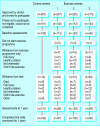Effectiveness and economic evaluation of a nurse delivered home exercise programme to prevent falls. 2: Controlled trial in multiple centres
- PMID: 11264207
- PMCID: PMC30095
- DOI: 10.1136/bmj.322.7288.701
Effectiveness and economic evaluation of a nurse delivered home exercise programme to prevent falls. 2: Controlled trial in multiple centres
Abstract
Objectives: To assess the effectiveness of trained nurses based in general practices individually prescribing a home exercise programme to reduce falls and injuries in elderly people and to estimate the cost effectiveness of the programme.
Design: Controlled trial with one year's follow up.
Setting: 32 general practices in seven southern New Zealand centres.
Participants: 450 women and men aged 80 years and older.
Intervention: 330 participants received the exercise programme (exercise centres) and 120 received usual care (control centres); 87% (371 of 426) completed the trial.
Main outcome measures: Number of falls, number of injuries resulting from falls, costs of implementing the programme, and hospital costs as a result of falls.
Results: Falls were reduced by 30% in the exercise centres (incidence rate ratio 0.70, 95% confidence interval 0.59 to 0.84). The programme was equally effective in men and women. The programme cost $NZ418 (121 pound sterling) (at 1998 prices) per person to deliver for one year or $NZ1519 (441 pound sterling) per fall prevented. Fewer participants had falls resulting in injuries, but there was no difference in the number who had serious injuries and no difference in hospital costs resulting from falls in exercise centres compared with control centres.
Conclusions: An individually tailored exercise programme, delivered by trained nurses from within general practices, was effective in reducing falls in three different centres. This strategy should be combined with other successful interventions to form part of home programmes to prevent falls in elderly people.
References
-
- Campbell AJ, Robertson MC, Gardner MM, Norton RN, Buchner DM. Falls prevention over 2 years: a randomized controlled trial in women 80 years and older. Age Ageing. 1999;28:513–518. - PubMed
-
- Campbell AJ, Borrie MJ, Spears GF. Risk factors for falls in a community-based prospective study of people 70 years and older. J Gerontol Med Sci. 1989;44:112–117. M. - PubMed
Publication types
MeSH terms
LinkOut - more resources
Full Text Sources
Medical

